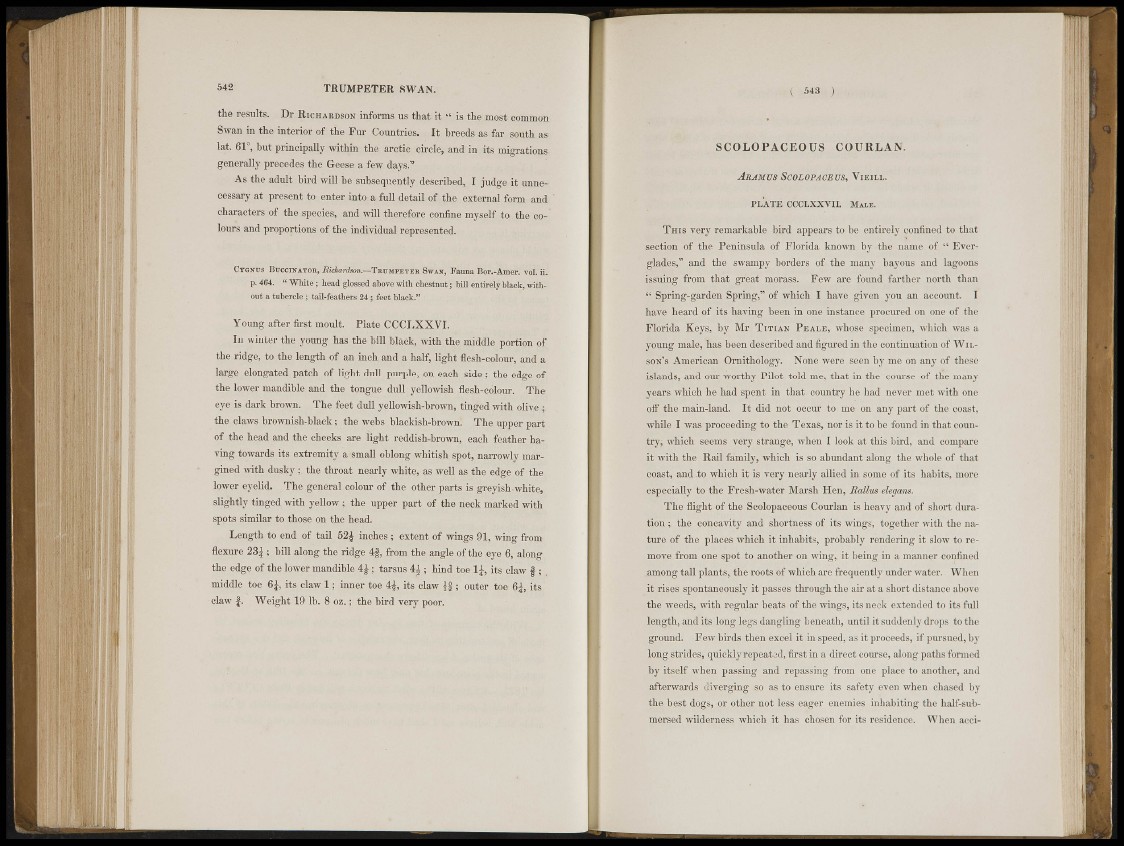
542 TRUMPETER SWAN.
the results. Dr RICHARDSON informs us that it " is the most common
Swan in the interior of the Fur Countries. It breeds as far south as
lat. 61°, but principally within the arctic circle, and in its migrations
generally precedes the Geese a few days,"
As the adult bird will be subsequently described, I judge it unnecessary
at present to enter into a full detail of the external form and
characters of the species, and will therefore confine myself to the colours
and proportions of the individual represented.
CTGNTIS BUCCINATOR, Richardson.—TRUMPETER SWAN, Fauna Bor.-Amer. vol. ii_
P- 464. " Whi t e ; head glossed above with chestnut; bill entirely black,, without
a tubercle; tail-feathers 24; feet black."
Young after first moult. Plate CCCLXXVI.
In winter the young has the bill black, with the middle portion of
the ridge, to the length of an inch and a half, light flesh-colour, and a
large elongated patch of light dull purple, on each side j the edge of
the lower mandible and the tongue dull yellowish flesh-colour. The
eye is dark brown. The feet dull yellowish-brown, tinged with olive ;
the Claws brownish-black; the webs blackish-browni The upper part
of the head and the cheeks are light reddish-brown, each feather having
towards its extremity a small oblong whitish spot, narrowly margined
with d u s k y t h e throat nearly white, as well as the edge of the
lower eyelid. The general colour of the other parts is greyish-white,
slightly tinged with yellow; the upper part of the neck marked with
spots similar to those on the head.
Length to end of tail 52£ inches ; extent of wings 91, wing from
flexure 23| ; bill along the ridge 4f, from the angle of the eye 6, along
the edge of the lower mandible 4£; tarsus ; hind toe its claw § ;
middle toe its claw 1 ; inner toe 4£, its claw ; outer toe its
claw f. Weight 19 lb. 8 oz.; the bird very poor.
| 543 |
S C O L O P A C E O U S COURLAN.
ARAM us SCOLOPAOEUS, VIEILL.
PLATE CCCLXXVIL MALE.
THIS very remarkable bird appears to be entirely confined to that
section of the Peninsula of Florida known by the name of " Everglades,"
and the swampy borders of the many bayous and lagoons
issuing from that great morass. Few are found farther north than
" Spring-garden Spring," of which I have given you an account. I
have heard of its having been in one instance procured on one of the
Florida Keys, by Mr TITIAN PEALE, whose specimen, which was a
young male, has been described and figured in the continuation of WILSON'S
American Ornithology. None were seen by me on any of these
islands, and our worthy Pilot told me, that in the course of the many
years which he had spent in that country he had never met with one
off the main-land. It did not occur to me on any part of the coast,
while I was proceeding to the Texas, nor is it to be found in that country;
which seems very strange, when I look at this bird, and compare
it with the Rail family, which is so abundant along the whole of that
coast, and -to which it is very nearly allied in some of its habits, more
especially to the Fresh-water Marsh Hen, Rcdlus elegans.
The flight of the Scolopaceous Courlan is heavy and of short duration
; the concavity and shortness of its wings, together with the nature
of the places which it inhabits, probably rendering it slow to remove
from one spot to another on wing, it being in a manner confined
.among tall plants, the roots of which are frequently under water. When
it rises spontaneously it passes through the air at a short distance above
the weeds, with regular beats of the wings, its neck extended to its full
length, and its long legs dangling beneath, until it suddenly drops to the
ground. Few birds then excel it in speed, as it proceeds, if pursued, by
long strides, quickly repeated, first in a direct course, along paths formed
by itself when passing and repassing from one place to another, and
afterwards diverging so as to ensure its safety even when chased by
the best dogs, or other not less eager enemies inhabiting the half-submersed
wilderness which it has chosen for its residence. When acci